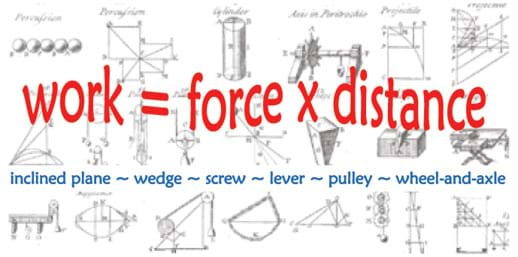
Summary
Through a five-lesson series with five activities, students are introduced to six simple machines—inclined plane, wedge, screw, lever, pulley, wheel-and-axle—as well as compound machines, which are combinations of two or more simple machines. Once students understand about work (work = force x distance), they become familiar with the machines' mechanical advantages, and see how they make work easier. Through an introduction to compound machines, students begin to think critically about machine inventions and their pervasive roles in our lives. After learning about Rube Goldberg contraptions—absurd inventions that complete simple tasks in complicated ways—they evaluate the importance and usefulness of the many machines around them. Through the hands-on activities, students draw designs for contraptions that could move a circus elephant into a rail car, create a construction site ramp design by measuring different inclined planes and calculating the ideal vs. actual mechanical advantage of each, compare the theoretical and actual mechanical advantages of different pulley systems conceived to save a whale, build and test grape catapults made with popsicle sticks and rubber bands, and follow the steps of the engineering design process to design and build Rube Goldberg machines.Engineering Connection
The fundamental mechanical devices that have come to be known as "simple machines" through the years are basic human inventions that help accomplish physical tasks through mechanical advantage. The same simple machines used by ancient engineers to build pyramids are employed by today's engineers to construct modern structures such as houses, bridges, roller coasters and skyscrapers. From everyday hand tools (crowbars, nails, wheels, ramps) to intricate "compound machines" that marry together many simple machines in endless combinations (pencil sharpeners, bicycles, elevators, medical devices, airplanes), engineers of all types continually work together to design better and more creative tools, devices, equipment and products of modern convenience that help people do more with less, incorporating the principles of simple machines.
Unit Overview
Overview of topics by lesson: 1) work [as defined by physical science] and the mechanical advantages of six simple machines that make work easier, 2) more about the inclined plane, wedge and screw, including each machine's mechanical advantages and work = force x distance, 3) more about the lever, pulley, and wheel-and-axle, 4) introduction to compound machines including an examination of machine inventions and their place in our everyday lives, and 5) introduction to Rube Goldberg contraptions, known for making simple tasks more difficult to complete, as a way to engage students in critical thinking to evaluate everyday machines.
Educational Standards
Each TeachEngineering lesson or activity is correlated to one or more K-12 science,
technology, engineering or math (STEM) educational standards.
All 100,000+ K-12 STEM standards covered in TeachEngineering are collected, maintained and packaged by the Achievement Standards Network (ASN),
a project of D2L (www.achievementstandards.org).
In the ASN, standards are hierarchically structured: first by source; e.g., by state; within source by type; e.g., science or mathematics;
within type by subtype, then by grade, etc.
Each TeachEngineering lesson or activity is correlated to one or more K-12 science, technology, engineering or math (STEM) educational standards.
All 100,000+ K-12 STEM standards covered in TeachEngineering are collected, maintained and packaged by the Achievement Standards Network (ASN), a project of D2L (www.achievementstandards.org).
In the ASN, standards are hierarchically structured: first by source; e.g., by state; within source by type; e.g., science or mathematics; within type by subtype, then by grade, etc.
See individual lessons and activities for standards alignment.
Subscribe
Get the inside scoop on all things TeachEngineering such as new site features, curriculum updates, video releases, and more by signing up for our newsletter!Unit Schedule
- Day 1: The Advantage of Machines lesson and A Simple Solution for the Circus activity
- Day 2: Just Plane Simple lesson
- Day 3: Tools and Equipment, Part I activity
- Day 4: Levers That Lift lesson
- Day 5: Machines and Tools, Part II activity
- Day 6: Not So Simple lesson
- Day 7: The Magician's Catapult activity
- Day 8: Rube Goldberg and the Meaning of Machines lesson and Design and Build a Rube Goldberg activity (first 25 minutes)
- Day 9: Design and Build a Rube Goldberg activity
More Curriculum Like This

Students are introduced to the six types of simple machines — the wedge, wheel and axle, lever, inclined plane, screw, and pulley — in the context of the construction of a pyramid, gaining high-level insights into tools that have been used since ancient times and are still in use today.

Refreshed with an understanding of the six simple machines; screw, wedge, pully, incline plane, wheel and axle, and lever, student groups receive materials and an allotted amount of time to act as mechanical engineers to design and create machines that can complete specified tasks.

Students expand upon their understanding of simple machines with an introduction to compound machines. This lesson encourages students to critically think about machine inventions and their role in our lives.

Students apply the mechanical advantages and problem-solving capabilities of six types of simple machines (wedge, wheel and axle, lever, inclined plane, screw, pulley) as they discuss modern structures in the spirit of the engineers and builders of the great pyramids.
Copyright
© 2007 by Regents of the University of ColoradoContributors
See individual lessons and activities.Supporting Program
Integrated Teaching and Learning Program, College of Engineering and Applied Science, University of Colorado BoulderAcknowledgements
This digital library content was developed by the Integrated Teaching and Learning Program under National Science Foundation GK-12 grant no. 0338326. However, these contents do not necessarily represent the policies of the National Science Foundation, and you should not assume endorsement by the federal government.
Last modified: April 10, 2020







User Comments & Tips